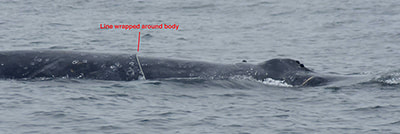Friday the 13th Lucky Day for Entangled Humpback Whale in Monterey Bay! It was a multi-day, community effort that ended in a humpback whale swimming free after it was successfully disentangled in Monterey Bay on Friday, December the 13th. Responders from the West Coast Large Whale Entanglement Response Network, including Marine Life Studies’ Whale Entanglement Team (WET)®, Cascadia Research, SR3 Sealife Response Rehab and Research, and The Marine Mammal Center Monterey Bay Operations (TMMC-MBO) staff, successfully removed all the fishing gear that was wrapped around the body of the young whale as seen in photos below. The whale was first reported by a fisherman on December 9th and the US Coast Guard (USCG) vessel, Pike, responded to and stood by but due to the whale's unpredictable behavior they had not seen it after the whale dove just as the response team arrived. The USCG along with the response team aboard Current'Sea, Marine Life Studies' Whale Rescue Research Vessel, which included members of our Whale Entanglement Team (WET)® and our partners Cascadia Research, SR3 Sealife Response Rehab and Research, and TMMC-MBO searched until dark. The following day, December 10th, the whale was spotted by Sea Spirit Ocean Safari, but unfortunately it was too late in the day to mount a response. On December 11th, a multi-agency search of Monterey Bay was conducted that included: USCG aircraft, the USCG vessel Pike, WET® vessel Current'Sea, the MBNMS vessel R4107, and Cascadia/SR3/TMMC team aboard vessel Musculus. Although the search turned up over 40 humpback whales, the entangled whale was not relocated.
On Friday the 13th, we left Moss Landing early to search for the entangled whale again during our Research Scientist Program, with trained WET® members aboard. While surveying and checking each humpback we came across, one of our other partners, Monte Ash with TowBoatUS Santa Cruz, spotted the entangled whale as he was towing a disabled boat to Moss Landing. Monte reported it to the hotline but also called us on the VHF radio with the coordinates. We were very close to that area and arrived within 15 minutes and located the entangled whale dragging buoys. We started the assessment process by recording the whale’s respirations and behavior while we waited for our network responders from SR3, Cascadia, and TMMC-MBO to come out in the TMMC-MBO vessel, Ever Lucan. By the time they arrived, we had a lot of valuable information; as we kept track of each dive sequence which included how long the animal remained on the surface, the number of breaths the whale took, when it dove, and how long the line with the buoys were at the surface after the whale dove. We also recorded a series of dive times so it gave us an idea when the whale would come up again. Recording the behavior of the whale from a respectable distance gave us a baseline to determine if the whale was calm or stressed on our initial arrival. This is important to know, because during a rescue, you can see if there were any changes in behavior that might give you a sign if the whale is stressed or agitated during the rescue process. We documented the entanglement with still and video cameras, trying to understand the complexity of the entanglement, meanwhile taking identification photos of its dorsal fin and tail flukes. The whale was very mobile and moved very quickly around the north side of Monterey Bay, approximately 7 to 9 miles WNW of Moss Landing. Once the rest of the response team arrived, we deployed our new WING, an inflatable boat designed specifically for whale disentanglement, thanks to our generous donors. The team approached the whale and attached A4 and A5 polyballs one at a time (a total of 5) to slow the down the fast moving whale and to keep the whale from diving, keeping it on the surface. They do this to work up and along the existing trailing gear to do the close up underwater assessment with a GoPro (underwater camera) on a long pole. Once that was complete, they returned to Current'Sea to review the footage on the computer and planned where the best cut would be to remove the entire entanglement. The response team determined the configuration was life threatening and the constricting wrap would cut into the whale’s body as it continued to grow. The response team returned to the whale with a fixed pole knife and a 30-foot carbon fiber pole.
This is dangerous work so please do not attempt to disentangle a whale! PLEASE call 1-877-SOS-WHALe (1-877-767-9245) or hail the USCG on VHF CH16. If you are able to standby please maintain a distance of 100 yds. until a trained response team arrives. Many thanks to the USCG for their outstanding support conducting the search and the reporting parties who reported and documented the entanglement. The response was a success because of the support from so many members of the community and highlights the importance of standing by an entangled whale while calling 1-877-SOS-WHALe (1-877- 767-9245) or hail the United States Coast Guard on VHF CH-16. All whale rescues are permitted under NOAA’s Marine Mammal Health and Stranding Response Program # 18786-04 by trained teams sanctioned by NOAA. All photos are copyrighted. Photos taken under the MMHSRP Permit. The Whale Entanglement Team (WET)® is part of the West Coast Large Whale Entanglement Response Network.
0 Comments
Leave a Reply. |
AuthorWrite something about yourself. No need to be fancy, just an overview. ArchivesCategories |

© Marine Life Studies. All rights reserved.
PO Box 163, Moss Landing, CA 95039
[email protected]
Marine Life Studies is a 501(c)(3) nonprofit organization, founded in 2006.
EIN #: 27-0318674
PO Box 163, Moss Landing, CA 95039
[email protected]
Marine Life Studies is a 501(c)(3) nonprofit organization, founded in 2006.
EIN #: 27-0318674





 RSS Feed
RSS Feed